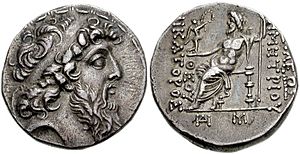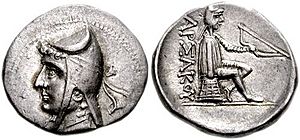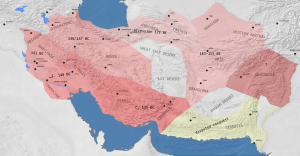Mithridates I of Parthia facts for kids
Quick facts for kids Mithridates I𐭌𐭄𐭓𐭃𐭕 |
|
|---|---|
| King of Kings, Arsaces, Philhellene | |
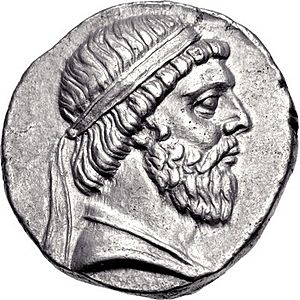
Mithridates I's portrait on the obverse of a tetradrachm, showing him wearing a beard and a royal Hellenistic diadem on his head
|
|
| King of the Parthian Empire | |
| Reign | 165–132 BC |
| Predecessor | Phraates I |
| Successor | Phraates II |
| Died | 132 BC |
| Spouse | Rinnu |
| Issue | Rhodogune Phraates II |
| Dynasty | Arsacid dynasty |
| Father | Priapatius |
| Religion | Zoroastrianism |
Mithridates I (also known as Mithradates I or Mihrdad I) was a powerful king of the Parthian Empire. He ruled from 165 BC to 132 BC. During his time as king, Parthia grew from a small kingdom into a huge empire. It became a major power in the Ancient East because of his many victories.
He first conquered lands like Aria, Margiana, and western Bactria from the Greco-Bactrians between 163 and 155 BC. Then, he fought against the Seleucid Empire. He took control of Media and Atropatene in 148 or 147 BC. In 141 BC, he conquered Babylonia and had a special ceremony in Seleucia. Soon after, the kingdoms of Elymais and Characene also came under Parthian control.
Around 140 BC, Mithridates was fighting against the nomadic Saka people in the east. The Seleucid king Demetrius II Nicator tried to win back his lost lands. Demetrius was successful at first, but he was defeated and captured in 138 BC. Mithridates I then sent him to one of his palaces in Hyrcania. Mithridates I also punished Elymais for helping Demetrius. He then made Persis a kingdom that paid tribute to Parthia.
Mithridates I was the first Parthian king to use the old title of King of Kings. This title was once used by the Achaemenid rulers. Because of his great achievements, people have compared him to Cyrus the Great, who founded the Achaemenid Empire. Mithridates I died in 132 BC, and his son Phraates II became the next king.
Contents
The Name Mithridates
The name "Mithridates" comes from the Greek way of saying the Iranian name Mihrdāt. This name means "given by Mithra". Mithra was an ancient Iranian sun god. He was very important in the Zoroastrian religion. Mithra was seen as the protector of khvarenah, which means kingly glory.
Mithra's importance grew during the time of the Greek Seleucid Empire. He was linked to Greek gods like Apollo or Helios. He was also linked to the Babylonian god Nabu. Mithra became most important under the Parthians. This might have been because Zoroastrians were trying to protect their faith from other religions spreading during the Hellenistic period.
Early Life
Mithridates was the son of Priapatius. Priapatius was the great-nephew of the first Arsacid king, Arsaces I. Mithridates had several brothers, including Artabanus. His older brother, Phraates I, became the Parthian king in 176 BC after their father.
Usually, a king's own son would take over after him. However, Phraates I broke this tradition. He chose his brother Mithridates to be his successor. A Roman historian named Justin said that Phraates I made this choice because he saw how very capable Mithridates was.
Mithridates' Reign
When Mithridates became king in 165 BC, his kingdom was one of many medium-sized powers. These kingdoms had grown stronger as the Seleucid Empire became weaker. Other kingdoms included Greco-Bactria, Cappadocia, and Armenia. Mithridates I's kingdom included parts of what is now Khorasan Province, Hyrcania, northern Iran, and southern Turkmenistan.
Conquering Lands in the East

Mithridates first focused on the Greco-Bactrian Kingdom. This kingdom was weak from fighting its neighbors. The new Greco-Bactrian king, Eucratides I, had taken the throne by force. This caused problems, like a rebellion by the Arians. Mithridates I might have supported this rebellion, as it helped him.
Between 163 and 155 BC, Mithridates I attacked Eucratides' lands. He defeated Eucratides and took control of Aria, Margiana, and western Bactria. Some historians believe Eucratides became a ruler who had to obey Parthia. The city of Merv became an important Parthian base in the northeast. Some of Mithridates I's bronze coins show an elephant on the back. This might have been to celebrate his victory in Bactria, as Greco-Bactrians also used elephant images on their coins.
Conquering Lands in the West
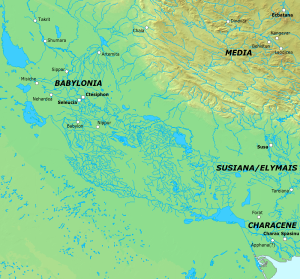
Mithridates then turned his attention to the Seleucid Empire. He invaded Media and captured Ecbatana in 148 or 147 BC. This area had recently been unstable after a rebellion. Mithridates I made his brother Bagasis the governor of Media. After this, Parthia also conquered Media Atropatene.
In 141 BC, Mithridates I captured Babylonia in Mesopotamia. He had coins made in Seleucia and held a special ceremony there. With Mesopotamia now under Parthian control, the empire's main focus shifted there from eastern Iran. Mithridates I then went to Hyrcania. His forces took over the kingdoms of Elymais and Characene and captured Susa. By this time, Parthian power reached as far east as the Indus River.
While Hecatompylos was the first Parthian capital, Mithridates I set up royal homes in Seleucia, Ecbatana, Ctesiphon, and his new city, Mithradatkert (Nisa). The tombs of the Arsacid kings were built and kept in Nisa. Ecbatana became the main summer home for the Arsacid royal family. This city had also been the capital for the Medes and a summer capital for the Achaemenid Empire. Mithridates I might have made Ctesiphon the new capital of his larger empire.
The Seleucids could not fight back right away because of a rebellion in their capital, Antioch. However, they got a chance around 140 BC when Mithridates I had to go east to deal with an invasion by the Saka people.
The Seleucid ruler Demetrius II Nicator at first succeeded in taking back Babylonia. But the Seleucids were eventually defeated, and Demetrius was captured by Parthian forces in 138 BC. He was shown to the Greeks in Media and Mesopotamia to make them accept Parthian rule. Then, Mithridates I sent Demetrius to one of his palaces in Hyrcania. Mithridates I treated him very well. He even married his daughter Rhodogune to Demetrius. This marriage was a way for Mithridates I to bring Seleucid lands into his growing Parthian empire. Mithridates I then punished the Parthian kingdom of Elymais for helping the Seleucids. He invaded the region again and captured two of their main cities.
Around the same time, Mithridates I conquered the southwestern Iranian region of Persis. He put Wadfradad II in charge as its frataraka. He gave Wadfradad II more freedom. This was probably to keep good relations with Persis, as the Parthian Empire was always fighting the Saka, Seleucids, and the Mesenians. Mithridates I was likely the first Parthian king to have an influence on Persis. The coins of Wadfradad II show that they were influenced by Mithridates I's coins. Mithridates I died around 132 BC, and his son Phraates II became king.
Coins and Royal Ideas
Since the early 2nd century BC, the Arsacid kings started to show clear signs on their coins. These signs connected them to the ancient Achaemenid Empire. For example, they falsely claimed that the first Arsacid king, Arsaces I, was a descendant of the Achaemenid King of Kings, Artaxerxes II.
Mithridates I was the first Arsacid ruler to use the old Achaemenid title of "King of Kings." Even though Mithridates I was the first to use this title again, it was not used often by Parthian rulers until his nephew, Mithridates II, started ruling around 109/8 BC.
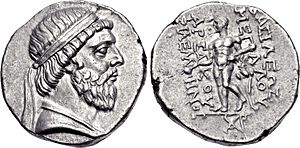
Before Mithridates I, Arsacid kings on their coins wore a soft cap called a bashlyk. This cap was also worn by Achaemenid governors. On the back of their coins, there was a seated archer in Iranian riding clothes. Mithridates I's first coins also show him wearing the soft cap. However, later coins from his reign show him wearing the royal Hellenistic diadem for the first time. This showed him as a Hellenistic king, but he kept his beard in the traditional Iranian style.
Mithridates I also called himself Philhellene ("friend of the Greeks") on his coins. This was a smart move to build good relationships with the Greek people he had just conquered. On the back of his new coins, the Greek hero Heracles is shown holding a club and a cup. In the Parthian era, Iranians used Greek images to show their own gods. So, Heracles was seen as a symbol of the Avestan god Verethragna.
Other titles Mithridates I used on his coins included "of Arsaces," which later changed to "of King Arsaces," and then "of the Great King Arsaces." The name of the first Arsacid ruler, Arsaces I, became a special title for later Arsacid kings to honor his achievements. Another title on Mithridates' coins was "whose father is a god." His son, Phraates II, also used this title later.
Building Projects
Under Mithridates I, the city of Nisa was completely changed. Nisa was a royal home for the Arsacid kings. It was renamed Mithradatkert ("Mithridates' fortress"). The city became a religious center to honor the Arsacid family. A sculpted head found in Mithradatkert, showing a bearded man with Iranian features, might be a portrait of Mithridates I.
Ctesiphon, a city on the Tigris River next to Seleucia, was founded during his rule. Some say the city was built as a camp for Parthian soldiers. Others say it was built to attract people away from Seleucia.
Mithridates' Legacy
Of all Mithridates' achievements, his greatest was changing Parthia from a small kingdom into a major power in the Ancient East. His conquests in the west seem to have been part of a plan to reach Syria. This would have given Parthia access to the Mediterranean Sea. Historians agree that Mithridates I's actions were not just random attacks for treasure. They were part of a clear plan to expand his empire. The historian Homa Katouzian has compared Mithridates I to Cyrus the Great, who founded the Achaemenid Empire.
Images for kids
-
The Xong-e Noruzi relief in Khuzestan. This relief shows six men, including a rider who might be Mithridates I.
See also
 In Spanish: Mitrídates I de Partia para niños
In Spanish: Mitrídates I de Partia para niños


